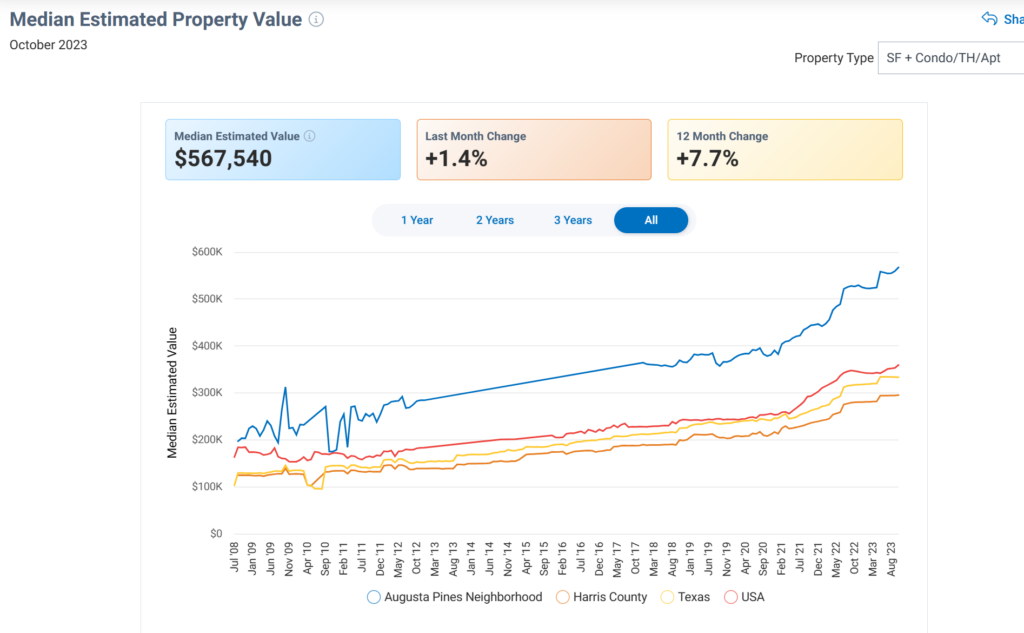Augusta Pines Real Estate Market Update and Trends November 08, 2023
In the world of real estate, there are several key metrics that can provide valuable insights into the current market conditions. Today, we will be discussing the correlation between months supply of inventory, 12-month change in months of inventory, median days homes are on the market, list to sold price percentage, and median sold price. This analysis is aimed at both buyers and sellers, as it can help them make informed decisions and navigate the ever-changing real estate landscape.
First, let's focus on the months supply of inventory, which is currently at 3.78. This metric represents the number of months it would take to sell all the available homes on the market, given the current sales pace. A lower number indicates a seller's market, where demand exceeds supply, potentially leading to higher prices. Conversely, a higher number suggests a buyer's market, where supply outpaces demand, potentially leading to lower prices. In this case, a months supply of inventory of 3.78 suggests a balanced market, where neither buyers nor sellers hold a significant advantage.
Now, let's examine the 12-month change in months of inventory, which stands at +44.27%. This metric demonstrates how the months supply of inventory has changed over the past year. A positive percentage indicates an increase in inventory, while a negative percentage signifies a decrease. In this scenario, the +44.27% change implies that there has been a substantial increase in the number of homes available for sale compared to the previous year. This increase in inventory might favor buyers, as they have more options to choose from and potentially negotiate better deals.
Moving on, we come to the median days homes are on the market, which currently stands at 25. This metric provides an indication of how long it takes, on average, for a property to sell after being listed. A shorter duration suggests a faster-paced market, with high demand and limited inventory. Conversely, a longer duration suggests a slower market, with lower demand and ample inventory. With a median of only 25 days on the market, it appears that properties are selling relatively quickly, indicating a healthy level of demand in the market.
Next, let's consider the list to sold price percentage, which is at 96%. This metric measures the percentage of the listing price that the property ultimately sells for. A higher percentage indicates that homes are selling close to or even above their initial listing price, suggesting a robust market with strong buyer demand. Conversely, a lower percentage suggests that homes are selling below their listing price, potentially indicating a weaker market. With a list to sold price percentage of 96%, it appears that properties are selling very close to their initial asking price, indicating a competitive market.
Lastly, we have the median sold price, which currently stands at $443,000. This metric represents the middle point of all the sold prices in a given period. It provides an understanding of the average price at which properties are being sold. A higher median sold price suggests a more expensive market, potentially favoring sellers, while a lower median sold price indicates a more affordable market, potentially favoring buyers. With a median sold price of $443,000, it indicates that the market is relatively competitive, with properties selling at a moderate price point.

In conclusion, the correlation between these real estate metrics suggests that the market is currently balanced, with a healthy level of demand and a reasonable amount of inventory available. The increase in the months supply of inventory compared to the previous year indicates a more favorable situation for buyers, providing them with more options. However, the relatively short median days on the market, high list to sold price percentage, and moderate median sold price indicate that sellers can still expect a competitive market. Both buyers and sellers should carefully consider these metrics when making their real estate decisions to ensure they are well-positioned in the current market conditions.
If you have any questions and need help with market trends and updates, reach out to Jennifer Yoingco, REALTOR®, and her team in The Houston Suburb Group, so you can get ready to EXPERIENCE LIVING IN HOUSTON, TEXAS!

Jeanette San Luis is a blog contributor, a double degree major in BS Chemical Engineering and BS Nursing, and graduated Magna Cum Laude and Summa Cum Laude respectively. She has won numerous accolades and was named one of Houston Chronicles TOP 150 Outstanding Nurses in 2016 and 2019. In her dual role as a REALTOR®, she empathizes and understands the needs of her clients; therefore, you are in very good hands.
Download our FREEBIES here!
The Ultimate Home Buyer's Guide
The Ultimate Home Seller's Guide
Find us on YouTube!
#jenniferyoingcorealtor #jenniferyoingco #JenniferYoingcoTexas #houstonsuburb #houstonsuburbs #houstonsuburbgroup #texasrelocationexperts #HoustonRelocationExpert #HoustonRelocationSpecialist #NurseRelocationExpert #NurseRelocationSpecialist #newhomeconstruction #thehighlands #ravennahomes #ravennahomesforsale #ravennahomesrealtor #ravennahomesrealestateagent #springtexas #tomballtexas #livinginhoustontexas #livinginhouston #thewoodlandstexas #conroetexas #montgomerytexas #cypresstexas #newcaneytexas #portertexas #katytexas #pearlandtexas #richmondtexas #fulsheartexas #sugarlandtexas #houstontexas #magnoliatexas #hockleytexas #pinehursttexas #jerseyvillagetexas #humbletexas



